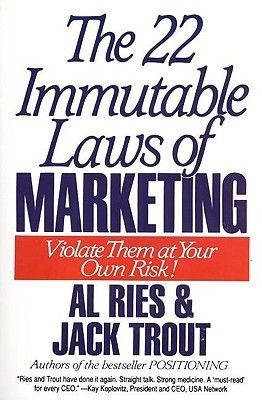The 22 Immutable Laws of Marketing by Al Ries & Jack Trout
The 22 Immutable Laws of Marketing by Al Ries & Jack Trout was an interesting summary of the many ways by which one can get ahead in the Marketing game.

The 22 Immutable Laws of Marketing by Al Ries & Jack Trout was an interesting summary of the many ways by which one can get ahead (or conversely, fail), at the Marketing game. The book is a bit dated, given that it was first published in 1993 - so some of its examples are old - but otherwise the various laws were clear and made sense.
From the Law of Leadership, to the Law of Resources, the book cumulatively made the point that marketing is not a game of chance. To be successful at it, one has to make moves that take advantage of the way the mind, and the market work.
Whether that means being the first to launch in your product category, or crafting a brand that captures the mind, or taking advantage of the market leader's position and offering something they overlooked, or even simply making sure you are the best at your core offering, tactics like these can help you succeed at making sure that your brand name comes out on top.
Through the content of the various laws, the book taught lessons like:
- Marketing is not a battle of products, it's a battle of perceptions.
- It is better to be first, than it is to be better
- The most powerful concept in marketing is owning a word in the prospect's mind
- Marketing effects take place over an extended period of time
- For every attribute, there is an opposite, effective attribute
These 5 laws and the remaining 17 like them, came with explanations, examples, and stories that made the laws believable. For example in "The Law of Leadership" i.e. "It is better to be first than to be better," the author gave examples of how most people remember the first brand to introduce a product, while second and third place remain forgotten. As with IBM in computers and Coca Cola with Cola.
As I mentioned at the beginning, the examples are a bit dated so you'll excuse the fact that IBM is currently no longer the leader in computers even though they were back in the day. But I digress... My point is "datedness" aside, the laws themselves still seem alive and kicking today.
Furthermore, some of the laws supplemented or complemented each other. So while you might think "ahn ahn, but we remember Pepsi with Coke or 7up with Sprite" when questioning The Law of Leadership, a law later in the book accounts for this. The Law of the Ladder which goes: "The strategy to use depends on which rung you occupy on the ladder." And I excerpt:
While being first in the prospect's mind ought to be your primary objective, the battle isn't lost if you fail in this endeavour. There are strategies to use for No. 2 and No. 3 brands.
Essentially saying that there are other methods to apply if the first law doesn't work out for you. And indeed, there are at least 22 laws to choose from in the marketing game. Like I said at the beginning, this book really summarized a good number of approaches, one can exploit in marketing.
All that said and done, I believe that when gunning for a position in your prospect's mind as a product/service of choice, The 22 Laws of Marketing provides a good primer. And like the authors say:
Violate them at your own risk